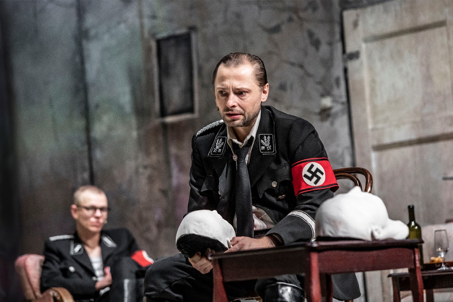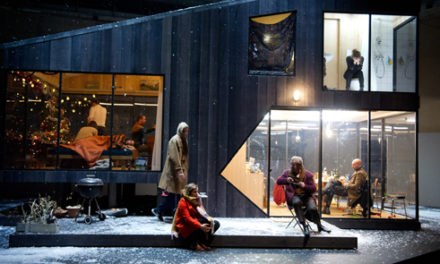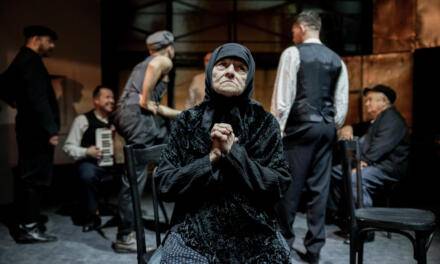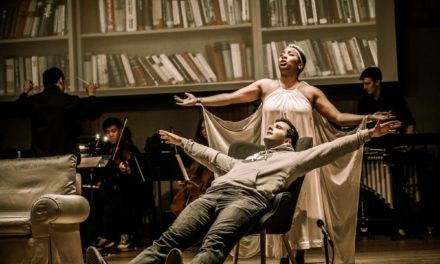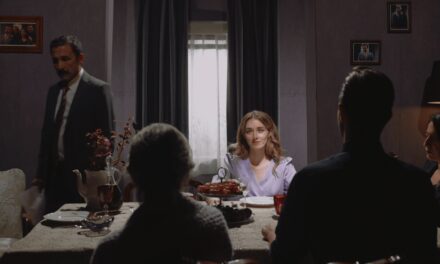Mid-September brought us a week of new, Polish theatre productions, and a sneak peek behind the curtains into the inner workings of Warsaw’s cultural institutions amid the pandemic’s second wave. The showcase provided a smoothly run facilitation of international cooperation, with plentiful networking opportunities and unparalleled artist approachability. The pandemic-marked, half-year review leaves theatres with financial uncertainty, yet also with a glimpse of hope for renewed interest and appreciation of the now long-missed live art form and a rare occasion to rethink how we understand liveness.
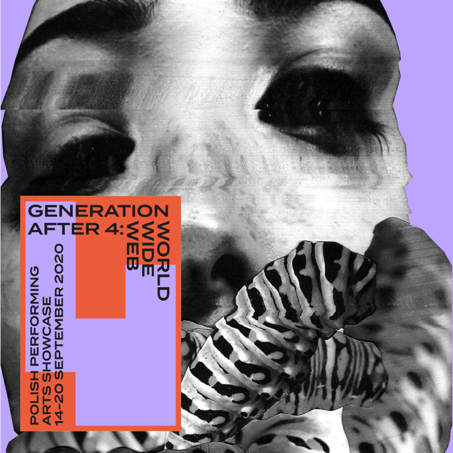
The festival poster by Martyna Wędzicka-Obuchowicz. Courtesy of Generation After.
Generation After 4 Showcase 9.14-19.2020
Putting aside the more theatrical works for now, the indicator that this was an online-only program was the intense schedule of artist and institution talks. Rather than providing the usual afterword and commentary to their shows, the artists could freely exchange ideas with the audience and offer a broad summary of Polish theatres’ struggles with the circumstances imposed by the pandemic’s strict restrictions. With the audience of foreign theater professionals seeking to strengthen ties beyond borders and artists looking for co-productions, access to the participating artists was made easy with 15-minute, one-on-one online meetings offered to industry guests.
The first talks included the directors and choreographers of Generation After 4. They highlighted the sudden shifts in daily routines that now consist of working from homes often filled with children attending school remotely. Of course, that impacted their ability to work. These talks offered personal insight on each artist and an intimate account of how they went managed to work during this time.
They also discussed one of the biggest pains an artist can endure – the unwanted and circumstantial change to the work itself. “How do we translate live performance into a video recording?” was a question each of the artists suddenly had to answer. Although almost none of the directors were happy to switch to a digital medium, this often meant choosing between video or nothing. Some aspects have indeed been lost given the change in the work’s ontology; as the performance no longer materializes in the same space as the viewers, it is now to be perceived in the same way movies are, through their distorting optics.
Lockdown has not helped with future work, either. It has shut everyone up at home, away from usual sources of creative stimuli. On the other hand, it presented artists with a challenge and the chance to reflect on video as a medium.
This is not to say that Polish artists, in spite of difficulties, stand still. Energy and the will to work are there and cannot wait for an outlet. Some of the showcase’s participating theatres launched lockdown-specific programs, such as Nowy Teatr. They have just premiered a Zoom-based play entitled Enter Full Screen, directed by Wojtek Ziemilski. However, Polish theatre creatives look forward to returning to their natural environment on stage, with a new freshness and having had plenty of time for hopefully-fruitful, conceptual work.
Two topics that reigned supreme in near future’s playbills were the political milieu of right-wing populism and its insular chauvinism, revisionary national history and identity politics, and the treatment of women in Poland. The latter was hit most severely by the pandemic given Poland’s conservative society leaves duties relating to home-schooling children on their shoulders, while lockdown traps domestic abuse victims with perpetrators. Further, women still work in highly unequal conditions and are unlikely to receive fair contracts and pay.
Unjust economic systems equally put art workers in a disadvantaged position, which the pandemic further exacerbates. The directors and choreographers of Generation After 4 highlight the hardship their colleagues face when freelancing, working without contracts, and only paid when projects are finished. They are excluded from governmental schemes helping employers cover part of their regular artists’ monthly wages.
Social distancing restrictions unfairly impact theatre as well. One wonders why the same people are safe to board a plane but not attend a show together. While the government aid to the arts, though truly appreciated and life-saving for several institutions, does not guarantee comprehensive compensation in the long run if spending on cultural participation falls and inflation soars.
Institutions, whose representatives, creative directors, and vice-heads were platformed in the second series of talks. They struggle with problems of their own that go beyond the financial side of their jobs. In terms of organizational work, lockdown necessitated a quick transition from no or nearly no online events to expeditiously concocting an array of digital content.
As artists recalled the hardship of their colleagues working without contracts, curators and researchers asked us not to forget similar people in their own fields. The expenditure of theatres during the pandemic resulted in new costs such as expanding legal expenses due to rights costing more when the performance is uploaded and preserved online.
The second group of talks was more optimistic. Firstly, they addressed participation. Publishing recorded shows online eliminates geographical and financial barriers that previously prevented so many from accessing theatre. Now, it is possible to experience it in the same way as everyone else. Second, the lockdown made us realize how much we need theatre and how we long for it, hinting at a greater social appreciation of the art form in the future.
Regarding the question of the nearest seasons’ favorite topics, the curators and institution representatives place their bet on “liveness”, in the meaning coined by Philip Auslander. It is a strange thing that the new coronavirus-imposed hierarchy of liveness means the highest-ranked and most sought-after events are the ones which are livestreamed.
As well as the struggles it creates for artists, video recording and livestreaming generate technical difficulties, too. They impose a requirement on theatres to provide technology and suitably-qualified staff to record, distribute, and in some cases monetize online material.
But technology and accessibility are where Generation After 4 is particularly successful and performs outstandingly well. Despite certain issues – with Zoom, of course – the online talks and show recordings were top-notch, the camerawork was but a minor distraction, and the audio quality was fine. The camera emulated the view from the auditorium and followed where we would look if we were physically attending. Zoom was used only when necessary, instead of what is usually seen in some British or American recordings where the camera operator, usually obsessed with close-ups, forgets that they are recording a theatre performance rather than making a movie out of it.

Jesus, dir. by Jędrzej Piaskowski, Nowy Teatr. Photo by Maurycy Stankiewicz. Courtesy of Generation After.
In the opening of Jesus, Jędrzej Piaskowski deftly juggles his native aesthetics of camp, Polish “kabaret” comedy shows, and retro pop culture. Every now and then he hits a lyrical note and disperses it all into dreams, all within Nowy Teatr’s signature, industrial-like, space lounge design. Yet, Jesus seems to escape the picture. Piaskowski turns to the too-well-known unspeakableness of the universal-yet-intimate religious feeling. This is contrasted against the culture of silencing outliers and outcasts with their experience being unheard. But contrasting everyone is the spaghetti monster (the fantastic Piotr Polak). By the way, Jesus is not spoken of, save in the title. Final verdict? Too much effort has been put into equalling Piaskowski’s remarkably successful 2017 debut Puppenhaus in its aesthetic quality, but there is not enough effort put into the dramaturgy.
The viewer leaves with a much better impression of Katarzyna Kalwat and her superb Rechnitz Opera – The Exterminating Angel. Testimonies by the perpetrators of a night mass murder of Jewish people fall apart and break into pathetically apologetic and desensitized tunes, while the string quartet does to opera what recitatives do to the true story. Elfriede Jelinek isn’t easy to stage, nor to read, but this impression seems alien to Kalwat and her cast.
Woyzeck may be the best-loved text for Polish theatres, now simultaneously playing in The National Theatre in Warsaw and in TR Warszawa. The former is directed by Piotr Cieplak, and the latter, included in Generation After 4, is by the young Grzegorz Jaremko. This is not a run-of-the-mill Woyzeck, however. Jaremko digs the problem of formation and shaping of masculine identity out of the play, arriving at a cruel cartoonish Bildungsspiel. Jaremko toys with the use of masks, a simple and ancient trick, yet so powerful and so on point in this case.
Erasmus fits in the aim of Generation After 4 most neatly, being that it is the child of an international project, bred by a multinational cast, and invites the multinational professionals in the audience to do it again. Anna Smolar brings German, Croat, and Polish actresses and actors together to ponder the future of Europe or to provide an epitaph for it. With unfeigned irony, she places Erasmus students – the symbols of flourishing party life and the citizens of 01:00am downtown Warsaw – on a pedestal as unified Europe’s saviors.
Magda Szpecht’s Always Coming Home seems the most accessible play, even though access is something Poland isn’t naturally good at. It works on an Ursula Le Guin text and tackles a problem we are all too aware of and too hesitant to acknowledge in our actions, though it is now a universal one. Szpecht navigates the futuristic convention with ease. There are no spacey gadgets but it is perfectly able to point to the change needed in social and human-environment relations that Le Guin envisions for future generations. Importantly, this show initially premiered in Japan where half of the cast was Japanese.
Capri, The Island of Fugitives by Krystian Lupa – one of the most successful and honored directors in Poland nowadays – is an exception to Generation After 4’s policy of promoting young artists, but promises to end the event with a bang. Yet, all to be heard was, at best, an elongated and tiresome whimper and the audience’s yawn. We spend five hours following Curzio Malaparte – fatigued and virtually voiceless – through different locations populated with moody artists, suffering something in between social exclusion and spoiled splendid isolation. They lack a sense of life and art, are traumatized by wars or entertain naïve dreams of systems and revolutions too perfect to be true. These, however, seem to have hardly any line of reasoning other than chronological narration that does not lead to any point of focus.
Despite some admirable acting by Powszechny’s cast, this was not the Lupa we know, but this was also not entirely his fault. Hearing Lupe’s voice from off-stage was crucial to understanding some of the arcs fully. Curiously, I couldn’t see the English translation of what the voice was saying on my screen. This gave me unusual inspiration to cherish knowing how to speak Polish, though. Generation After 4 is, after all, all about artists at the beginning stages of their careers, and their shows are what I will remember most fondly. For their promotion, we should be most thankful to the curators.
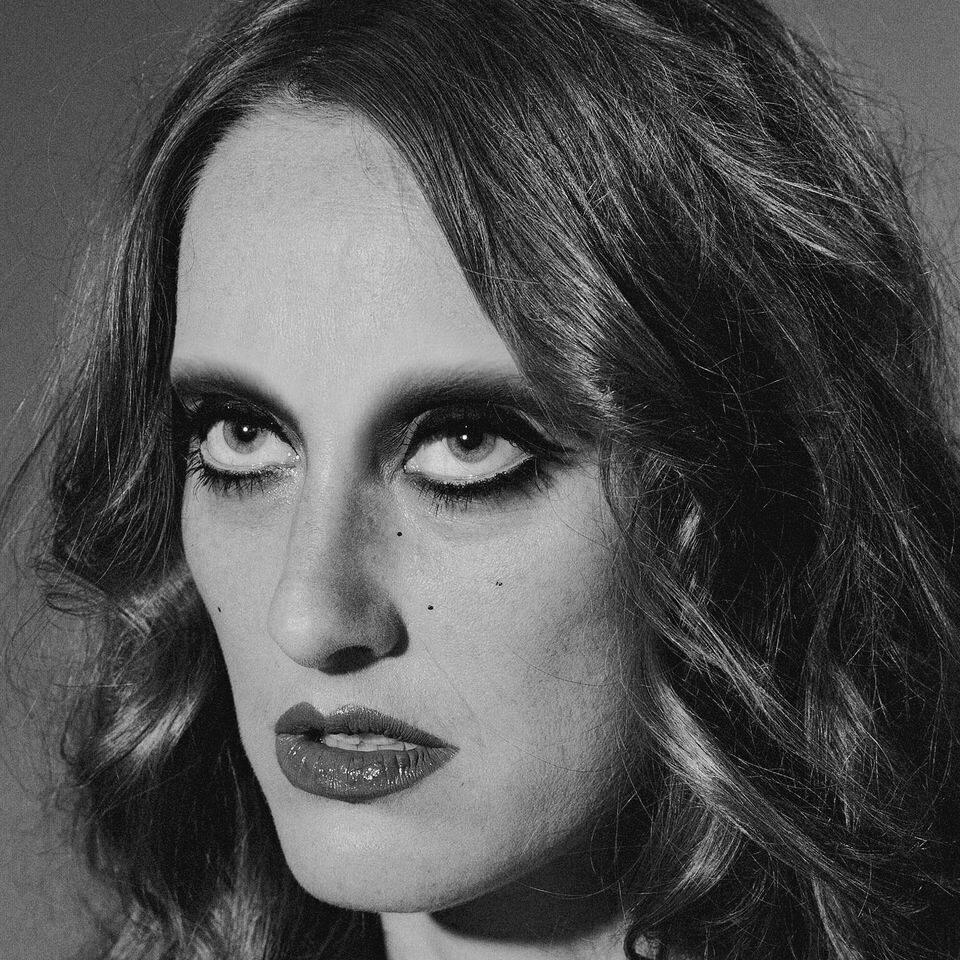
Ramona Nagabczyńska in her (direction and choreography) Body Parts, STUDIO theatregallery. Photo by Witek Orski. Courtesy of Generation After.
Along with theatrical shows, there was performance art and dance. Though so far I have focused on the core theatrical – as understood in a narrow sense – part of Generation After 4, the importance of these forms in Poland is not to be underestimated. They are growing in importance and popularity as people become more aware of them. Two of the participating institutions – Komuna Warsaw and STUDIO theatregallery – host dance almost as often as theatrical works. Contemporary art galleries successfully act as venues for performance in Poland, with Ujazdowski Castle and Zachęta National Gallery in the lead. After all, these shows are theatrical, in a way. What first comes to mind is Ramona Nagabczyńska’s study of the identity-defining potential of the face in the piece called Body Parts.
It is indeed a strange time to report from Generation After 4 because five days before this article goes online, and three and a half weeks after the last show of the event, Warsaw sees new restrictions including one further reducing the number of seats in theatres to one-fourth of the venue’s maximum capacity. This means that all institutions participating in Generation After 4 will suffer even more. Who knows how many shows this fall in Warsaw will be played with more actors on stage than guests allowed to see them?
This post was written by the author in their personal capacity.The opinions expressed in this article are the author’s own and do not reflect the view of The Theatre Times, their staff or collaborators.
This post was written by Franciszek Bryk.
The views expressed here belong to the author and do not necessarily reflect our views and opinions.

